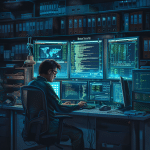Art and historical exhibitions are the gateway to a different time and place. They offer an immersive experience that stimulates our curiosity and imagination. However, the advent of technology, particularly augmented reality (AR), promises to take this experience to a surprising new level. With AR, museums and art galleries can create interactive displays that not only entertain but also educate visitors in a unique and engaging way.
The Intersection of Art and Technology
Art and technology might seem like strange bedfellows, but they’ve been inextricably linked for centuries. Artists often leverage the latest technological advancements to push the boundaries of their craft. Today, augmentative reality is one such technology that artists are using to enhance their artworks and exhibitions.
A lire également : Can Technology Enhance Art Preservation Techniques for Future Generations?
The marriage of art and augmented reality is not merely about using technology for technology’s sake. Instead, it’s about enhancing the overall experience of the visitor. By incorporating AR into exhibitions, artists and museums can create multi-dimensional, interactive experiences that merge the physical and digital worlds.
Augmented reality can help to breathe new life into static artworks, allowing visitors to engage with them in entirely new ways. For example, an artist might use AR to add a layer of animation to a painting, causing characters or objects within the painting to move and interact when viewed through an AR-enabled device.
Dans le meme genre : What’s the Impact of Nanotechnology on Creating More Efficient Photovoltaic Cells?
Transforming the Museum Experience
Museums are cultural staples, preserving and displaying our shared history and heritage. However, traditional museum visits can often feel passive and one-dimensional, especially for younger, digitally-savvy generations. Augmented reality presents an opportunity to transform the museum experience into something altogether more engaging and immersive.
AR technology can be integrated into a museum’s app, allowing visitors to view exhibits through their smartphones or tablets. This could involve providing additional information about a particular artifact or artwork, or it could mean superimposing animation or 3D models onto the exhibit.
For example, a museum might use AR to recreate historical scenes, allowing visitors to see how a particular artifact was used in its original context. This not only makes the museum visit more exciting and interactive but also helps to deepen visitors’ understanding of the exhibits.
Augmented Reality and the Future of Exhibitions
As we look towards the future, it’s clear that augmented reality is set to play a significant role in the way we experience art and historical exhibitions. The technology offers endless possibilities for artists and museums to bring their exhibits to life, creating immersive, interactive experiences that go beyond the limits of traditional displays.
Virtual and augmented reality technologies can provide an enhanced level of accessibility for those who may not have the means to visit museums or art galleries in person. These technologies can create virtual exhibitions that can be accessed from anywhere in the world, breaking down geographical barriers and making cultural and artistic experiences more inclusive.
The Art of Creating Immersive Experiences
The potential of augmented reality extends beyond simply adding a layer of digital information to physical objects or spaces. The technology can be used to create entirely new, immersive experiences that blur the line between reality and fiction.
Artists can use AR to create site-specific installations that respond to the viewer’s location and movement. These installations can be designed to alter and evolve over time, creating a dynamic, ever-changing experience that is unique to each visitor.
Overall, the integration of augmented reality into art and historical exhibitions represents an exciting new frontier for the cultural sector. As the technology continues to evolve, we can expect to see even more innovative and immersive experiences that challenge our perceptions of what is possible in the realm of art and history.
The Impact of Augmented Reality on Art Exhibitions
Art exhibitions are not just about viewing static pieces; they are about connecting with the artwork, understanding the artist’s intent, and inspiring individual interpretation. Augmented reality opens up new possibilities for deepening this connection. AR can go beyond adding interactive elements and may even alter the way we interact with and perceive art.
The potential for AR in art is vast; it can provide additional insights into an artist’s life, work methodology, or the social and historical context of an artwork. For instance, at an exhibition of Van Gogh’s work, augmented reality could allow visitors to explore a 3D representation of the artist’s studio, listen to excerpts from his letters, or even step into one of his vibrant landscapes. This could provide an immersive experience that broadens the understanding of Van Gogh’s life and work in a way that traditional exhibits cannot provide.
Moreover, AR can make art more accessible and engaging to younger generations. Traditional art exhibitions can sometimes seem daunting or dull to younger visitors. However, adding an interactive AR layer can make the experience more engaging and relatable to digital natives.
In addition, augmented reality can also be used to preserve and restore art. For example, AR can recreate artworks that have been lost or damaged over time, allowing visitors to see them as they originally appeared. This not only enhances the visitor experience but also plays a crucial role in preserving our cultural heritage.
Augmented Reality in Museums: The Next Frontier
Museums, such as the National Museum of Natural History or the National Museum in Singapore, have long been revered as custodians of human history and culture. Traditional museums offer a wealth of knowledge, but they often lack engaging and interactive elements. However, augmented reality has the potential to revolutionize the visitor experience in these institutions.
Imagine walking through a natural history museum and, instead of merely reading about the dinosaurs, using your AR-enabled device to bring these incredible creatures to life in front of your eyes. Not only would this create a more engaging experience, but it also offers a more effective learning environment, especially for children.
A museum’s augmented reality app could also be used to provide audio tours, navigational assistance, or even language translation, all of which can significantly enhance the visitor experience. Moreover, AR can help visually-impaired visitors to engage with the exhibits in a more meaningful way by providing audio descriptions or tactile feedback.
Another exciting possibility is the creation of virtual exhibitions. These can offer remote access to the museum’s collections, allowing people from around the world to explore the exhibits without leaving their homes. This not only extends the reach of the museum but also makes cultural learning more inclusive and accessible.
Conclusion: Embracing the Potential of Augmented Reality
As we peek into the future, the potential of augmented reality in the realms of art and history is undeniable. While the technology is still evolving, its current applications in art exhibitions and museums demonstrate a promising trajectory.
By merging the physical and digital worlds, augmented reality can create immersive and engaging experiences that go beyond what traditional exhibits offer. Whether it’s exploring Van Gogh’s studio, bringing dinosaurs back to life, or delving into a virtual exhibition, AR offers a new dimension to how we experience art and history.
The advent of AR helps to bridge the gap between younger, digitally-savvy generations and the conventional gallery-going audience, making art and history more accessible and appealing to a broad audience. As the technology continues to evolve, it will undoubtedly unlock even more exciting possibilities. The future of art and historical exhibits is undoubtedly more interactive, more accessible, and more immersive, thanks to augmented reality.











